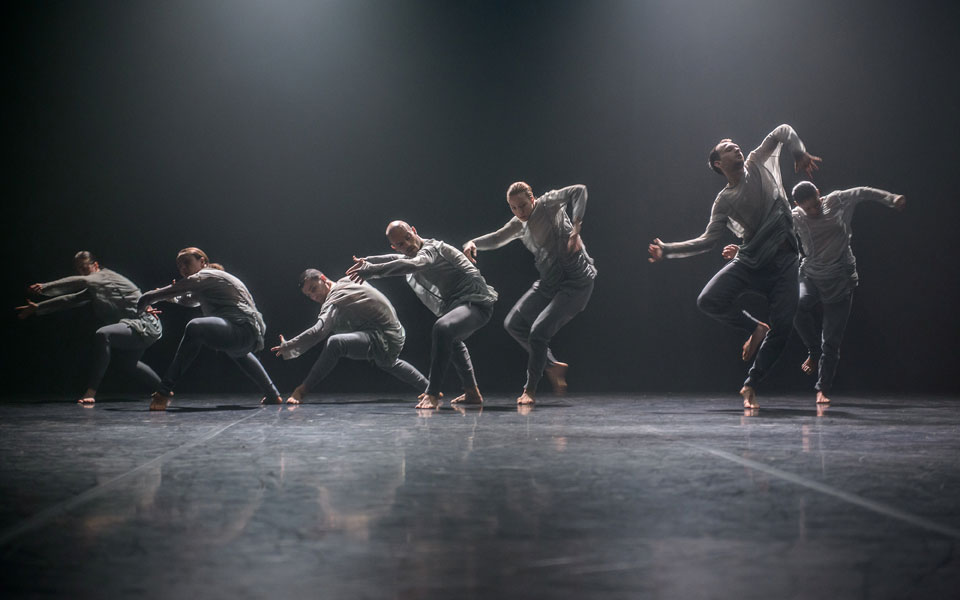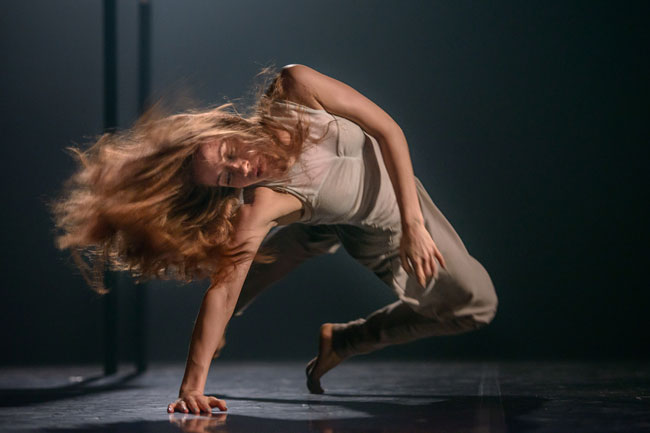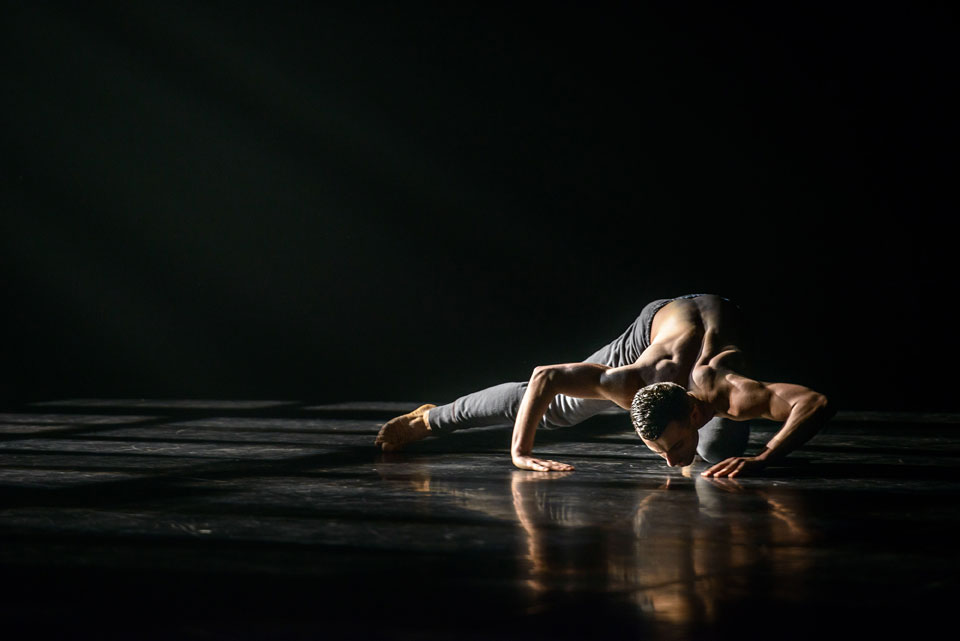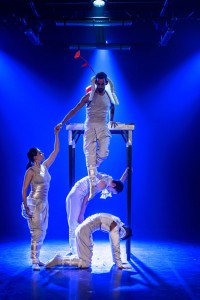This spring of 2015 Dansk Danseteater went on tour with Carmina Burana. A real success that filled theatres everywhere in Denmark and triggered great reviews in Germany too. But how did they go about it? Could it have anything to do with youth, passion and hard work?
By Iben Maria Hammer (art writer, Terpsichore)

Carmina Burana. Dansk Danseteater. Koreograf: Alessandro Sousa Pereira. Foto: Søren Meisner
With two different approaches the choreographers and dancers Alessandro Sousa Pereira and Fabio Liberti, both from Dansk Danseteater, took on the challenging task of turning the huge medieval work of music and lyrics, Carmina Burana, into a both playful and poetic modern dance performance about the rich and the poor being in love or going mad. And with great success!
Strong theatrically music
Carl Orff’s subtle and satirical piece is divided into two parts. Fabio Liberti got the first part and Alessandro Sousa Pereira the second part. “We are very different choreographers and we wanted to use that”. Listening to Carmina Burana in the beginning of the process brought a lot of images to his mind, Fabio Liberti says, stressing that it is very strong theatrically music. He then looked for images and also looked into director Robert Wilson’s “The Sheakspeare Sonettes”, a theatre director known for starkly minimalist settings, luminous backdrops and actors “in white bright makeup, looking like merry or morbid ghouls”.
 Carmina Burana. Dansk Danseteater. Koreograf: Fabio Liberti. Foto: Søren Meisner
Carmina Burana. Dansk Danseteater. Koreograf: Fabio Liberti. Foto: Søren Meisner
Lipsinking in latin
Fabio Liberti also showed Hieronymus Bosch paintings to the dancers. The early Netherlandish painter whose works depict sin and human moral failings can easily be associated with Carmina Burana which Fabio Liberti describes as being “a bit over the top with a bitter taste”. He went into the old texts and used some of the elements and the spirit of making fun of everything serious. He used the satire to make fun of Carl Orff’s music and the work itself the way that Carl Orff himself made fun of the people. One hilarious example being when the agile Italian dancer, Luca Marazia, is lipsinking in latin.
Mentally disturbed
Listening to the music and reading the lyrics of Carmina Burana resulted in Alessandro Sousa Pereira using Fabio Liberti’s mentally disturbed dancers as the link to the second part. Inspired by Woody Allen’s “Blue Jasmin” where Cate Blanchett plays the role as someone who is considered crazy but who might actually not be, and also by Paulo Coelho’s “Veronika Decides to Die”, his characters are locked up in a hospital for mentally ill people.
“They see the light come and go and understand that they are never going to get out of there. They start to discover the room and become scared of each other, in fact of everything. The windows make them think, they are being watched which makes them even more crazy”, Alessandro Sousa Pereira explains. Seeing the light for the first time has a strong impact on them and the dancers are eminently creating the illusion of poor imprisoned people pushed beyond the limits of being sane with curved fingers and tormented expressions.
 Carmina Burana. Dansk Danseteater. Koreograf: Alessandro Sousa Pereira. Foto: Søren Meisner
Carmina Burana. Dansk Danseteater. Koreograf: Alessandro Sousa Pereira. Foto: Søren Meisner
Quite intense
There were two casts for each piece, each group with slightly different interpretations, because, as choreographers, they use the personality a lot, Alessandro Sousa Pereira and Fabio Liberti agrees. Alessandro Sousa Pereira states that Carmina Burana, Songs of Beuren, is quite intense. The people portrayed in the piece were soldiers being a little crazy, drinking and writing and not seeing things clearly. Fabio Liberti says that actually there are very sexual parts too, like in the beginning of the second part where everybody, both women and the soldiers without restrictions are behaving very drunk in The Taverna.
Believing in the choreographer
Fabio Liberti and Alessandro Sousa Pereira use very different movement language, and they work differently too. Fabio Liberti began with something very abstract, then build the piece up theatrically, made some costume changes, had more characters appear and then later he added the podiums and build the scene that way. He made something like a storyboard where he imagined the queen, the princess and the homeless and worked a lot with the dancers, telling them “this is who you are” inventing the moves together with them.
Alessandro Sousa Pereira took a lot from the book “Veronika Decides to Die” and made workshops with an actress to make the dancers get to know their character. He knew the vocabulary and how it should look on the dancers. But this was a base, not a structure. “I had the room, and then I got a lot from the dancers”. They believed in him, and therefore their part and the process started to float. “I had to make them believe what I think is the definition of crazy or “what crazy is”. They put themselves in your hands, so it is important they trust you”.
Fabio Liberti adds that even if you try to explain, the dancers might not know exactly what you mean. Sort of like leading a blind, I imagine. He also had them cross a personal border by singing in Latin.
Carmina Burana. Dansk Danseteater. Koreograf: Fabio Liberti. Foto: Søren Meisner
Young and passionate
Obviously, getting the task of interpreting Carmina Burana with a crew of dancers was a huge challenge, because as Alessandro Sousa Pereira comments: people come with certain expectations when it comes to this massive piece of music. “But we are young and we have so much passion that it worked out”.
In the part of Fabio Liberti each dancer plays several characters. Therefore it seems as if there are twenty five dancers all together instead of seven. The point of all the small parts was that he didn’t want the story of each character but only the fragments like a presentation your mind can take further/build on.
The little accessories like a baroque collar helped the dancers changing character quickly and gave you the illusion of the historical chaos. Fabio Liberti’s movements are staccato and precise, and he likes when you really control the hands.
Alessandro Sousa Pereira worked a lot with the clothes in the choreography – like something you are trapped in – and with deep organic flowy movements. He wanted the visual language to be very clear. They both think, the costume designer did a great job, showing so much trust in them, listening carefully and all the time doing her best.
Asking a lot
Alessandro Sousa Pereira and Fabio Liberti both agree that the dancers were working very hard. They admit to having been really very demanding choreographers and stress that they didn’t settle for less than perfect, not giving up at any point. It was very hard for the dancers to do one piece being so precise and then doing the other with so much flow in the movements.
Fabio Liberti asked more of the dancers than usually. In the singing scene the dancers start from the back then turn to the audience. Fabio Liberti had a lot of eye contact with the dancers at this state, having to eliminate their shyness. “Because with the scene projecting to the audience you cannot hide anywhere”, he says. In the part of Alessandro Sousa Pereira on the other hand the back of the stage is used creating some distance to the audience and making it more internal.
Dansk Danseteater had one show in Germany. It went very well, and also in Denmark everything was sold out. Alessandro Sousa Pereira, when asked, thinks that the audience in Copenhagen is different than in the suburbs for instance. In Copenhagen the audience does not only come for the piece but to see the dancers too, where outside Copenhagen they are mainly attracted by the famous Carmina Burana. Tim Rushton sort of educates the audience though and it works, because people have started to come for Dansk Danseteater and not just any dance performance.
Constantly working minds
Fabio Liberti and Alessandro Sousa Pereira worked 37 hours a week in the studio. “And after three months we wanted our lives back”, they say. Alessandro Sousa Pereira explains that their minds were constantly working on the project and Fabio Liberti adds that he saw corrections in the middle of the night, but also that when working he was never thinking about the audience. Like when he got the idea with the horse carriage, he afterwards came to wonder what people who come to see dance would make of it. “But in the studio you are into your own ideas”, they agree “and you don’t think about the outside world”.

Carmina Burana. Dansk Danseteater. Koreograf: Alessandro Sousa Pereira. Foto: Søren Meisner
FACTS:
Carmina Burana by Dansk Danseteater, choreography by Alessandro Sousa Pereira and Fabio Liberti.
About the performance: review from the webmagazine Dans ONline
Info: Dansk Danseteater


